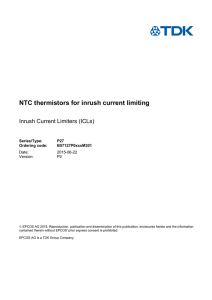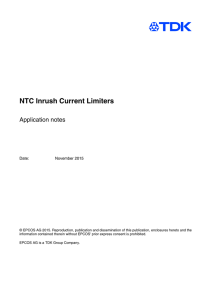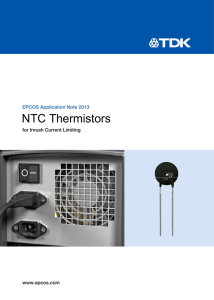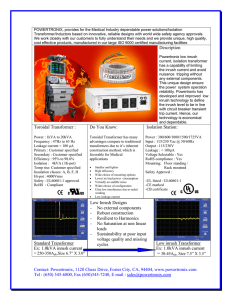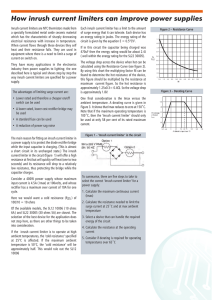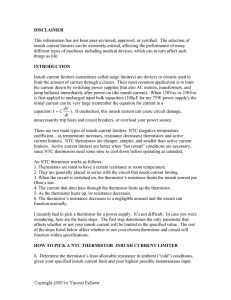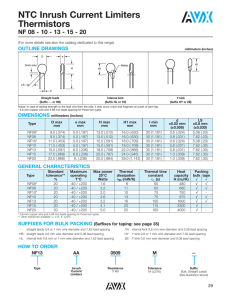Datasheet - Future Electronics
advertisement
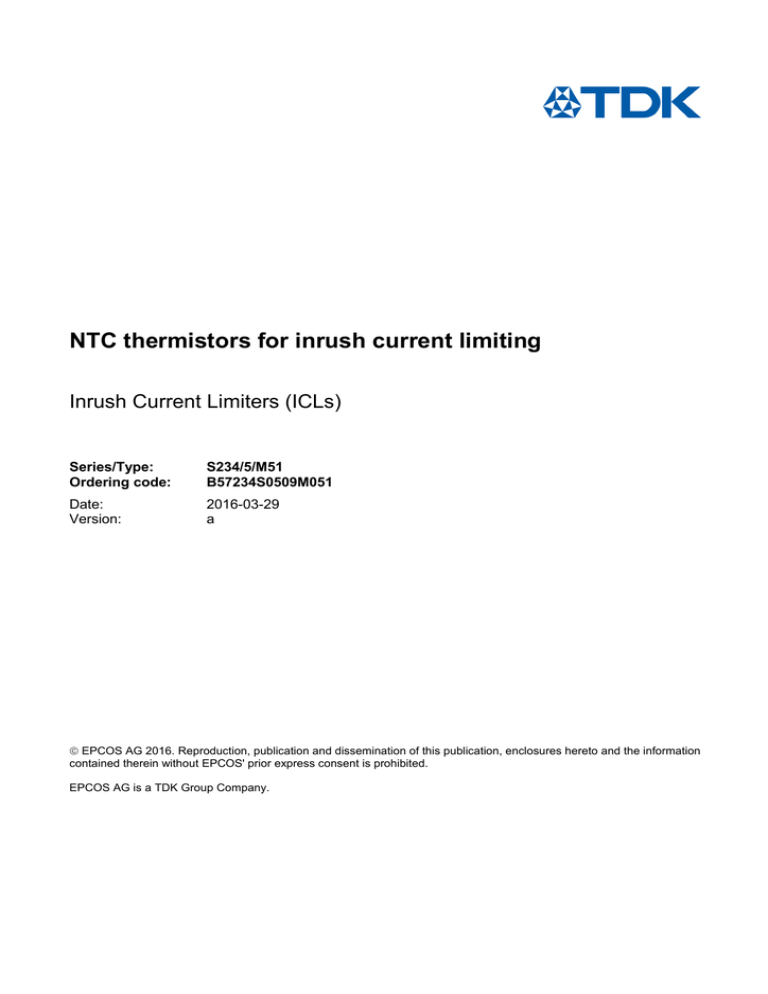
NTC thermistors for inrush current limiting Inrush Current Limiters (ICLs) Series/Type: Ordering code: S234/5/M51 B57234S0509M051 Date: Version: 2016-03-29 a Content of header bars 1 and 2 of data sheet will be automatically entered in headers and footers! Please fill in the table and then change the color to "white". This ensures that the table disappears (invisible) for the customer PDF. Don't change formatting when entering or pasting text in the table and don't add any cell or line in and to it! Identification/Classification 1 NTC thermistors for inrush current limiting (header 1 + top left bar): Identification/Classification 2 Inrush Current Limiters (ICLs) (header 2 + bottom left header bar): Ordering code: (top right header bar) B57234S0509M051 Series/Type: (bottom right header bar) S234/5/M51 Preliminary data (optional): Data sheet Department: PPD VAR PD Date: 2016-03-29 Version: a EPCOS AG 2016. Reproduction, publication and dissemination of this publication, enclosures hereto and the information contained therein without EPCOS' prior express consent is prohibited. EPCOS AG is a TDK Group Company. NTC thermistors for inrush current limiting Inrush Current Limiters (ICLs) B57234S0509M051 S234/5/M51 Data sheet Application • For inrush current limiting, e.g. in switch-mode power supplies, soft-start motors Features • Leaded and coated NTC thermistors • Tinned copper wire, kinked • Coating material flame retardant to UL 94 V-0 • Manufacturer's logo, NTC and resistance value stamped on • Highly stable electrical characteristics • UL approval (file number E69802) • IEC approval (certification number 101QA12) • VDE approval (certification number 40038223) • CQC approval (certification number CQC09001040539) • RoHS-compatible PPD VAR PD Please read Cautions and warnings and Important notes at the end of this document. 2016-03-29 Page 2 of 14 NTC thermistors for inrush current limiting Inrush Current Limiters (ICLs) B57234S0509M051 S234/5/M51 Data sheet Drawing b 15 max mm th 7 max mm h LL 22 max * mm mm LD 0.8 ±0.05 mm LS 7.5 ±0.8 mm (1) * Effective Lead length acc. taping spec. IEC 60286-2 1) Seating plane in accordance with IEC 60717 Approx. weight: 2.0 g General technical data Climatic category Max. power Resistance tolerance Rated temperature Dissipation factor Thermal cooling time constant Heat capacity (IEC 60068-1) (at 25 °C) 55/170/21 3.6 ±20 Pmax ∆R/RR TR δth τth Cth (in air) (in air) 25 approx. 17 approx. 90 approx. 1530 W Ω °C mW/K s mJ/K Electrical specification and ordering codes R25 Ω 5 Imax Ctest Ctest Rmin (0...65 °C) at 230 V AC at 110 V AC (at Imax, 25 °C) A 6.4 µF 700 µF 2800 Ω 0.09 PPD VAR PD Please read Cautions and warnings and Important notes at the end of this document. Ordering code B57234S0509M051 2016-03-29 Page 3 of 14 NTC thermistors for inrush current limiting Inrush Current Limiters (ICLs) B57234S0509M051 S234/5/M51 Data sheet Maximum continuous current Imax The Imax denotes the maximum permissible continuous current (DC or RMS values for sine-shaped AC) in the temperature range from 0 to 65 °C. Load derating (I / Imax) The power handling capability of an NTC thermistor cannot be fully utilized over the entire temperature range. For circuit dimensioning the derating curve given below provides information on the extent to which the current must be reduced at a certain ambient temperature (TA). I / Imax Percent of Imax = 1 T − 65° C 100 1 − A Tmax − 65° C TA = ambient temperature ( TA > 65°C ) Tmax = 170°C -25 0 Ta 170 65 Fig. 1 Maximum current derating (I / Imax ) Maximum permissible capacitance The currents during turn-on are much higher than the rated currents during continuous operation. To test the effects of these current surges EPCOS uses the following standard procedure according to IEC 60539-1: Thyristor switch RS Vload C test RT VNTC Vload Ctest Rs VNTC Load voltage [V] Test capacitance [µF] Series resistance [Rs = 1 Ω] Voltage drop across the NTC under test [V] = 180/375 V (corresponds (110/230 V + dV) x 1.41) TNT0358-L-E Fig. 2 Maximum switchable capacity measuring circuit Marking • • • • EPCOS – logo Resistance value NTC Date code with 4 digits (year and week of production): 1636 (example for week 36 in year 2016) PPD VAR PD Please read Cautions and warnings and Important notes at the end of this document. 2016-03-29 Page 4 of 14 NTC thermistors for inrush current limiting Inrush Current Limiters (ICLs) B57234S0509M051 S234/5/M51 Data sheet Reliability data Test Standard Test conditions ∆R25/ R25 (typical) Remarks Storage in dry heat IEC 60068-2-2 Storage at upper category temperature T: 170°C t: 1 000 h Storage in damp heat, steady state IEC 60068-2-78 Temperature of air: 40°C Relative humidity of air: 93 % Duration: 21 days < 20 % No visible damage Rapid change of temperature IEC 60068-2-14 Lower test temperature: -55 °C t: 30 min Upper test temperature: 170 °C t: 30 min Time to change from lower to upper temperature: < 30 s Number of cycles: 10 < 20 % No visible damage Endurance with max. current IEC 60539-1 < 20 % No visible damage < 20 % No visible damage < 20 % No visible damage < 20 % No visible damage Ambient temperature: 25 ±5 °C I = Imax t: 1000 h Ambient temperature: 25 ±5 °C Cyclic endurance IEC 60539-1 Maximum permissible capacitance test IEC 60539-1 I = Imax On-time = 1 min Cooling time = 5 min Number of cycles: 1000 Ambient temperature: 25 ±5 °C Capacitance = Ctest Number of cycles: 1000 Note The self-heating of a thermistor during operation depends on the load applied and the applicable dissipation factor. When loaded with maximum allowable current/power and the specified dissipation factor is taken as a basis, the NTC thermistor may reach a mean temperature of up to 250 °C. The heat developed during operation will also be dissipated through the lead wires. So the contact areas, too, may become quite hot at maximum load. When mounting NTC thermistors you have to ensure that there is an adequate distance between the thermistor and all parts which are sensitive to heat or combustible. PPD VAR PD Please read Cautions and warnings and Important notes at the end of this document. 2016-03-29 Page 5 of 14 NTC thermistors for inrush current limiting Inrush Current Limiters (ICLs) B57234S0509M051 S234/5/M51 Data sheet Solderability Test to IEC 60068-2-20 Preconditioning: Immersion into flux F-SW 32. Evaluation criterion: Wetting of soldering areas ≥95%. Solder Bath temperature (℃) Dwell time (s) SnAg (3.0 … 4.0), Cu (0.5 … 0.9) 245 ±3 3 Solder Bath temperature (℃) Dwell time (s) SnAg (3.0 … 4.0), Cu (0.5 … 0.9) 260 -5 10 Resistance to soldering heat Test to IEC 60068-2-20 Preconditioning: Immersion into flux F-SW 32. Soldering instructions When soldering, care must be taken that the NTC thermistors are not damaged by excessive heat. The following maximum temperatures, maximum time spans and minimum distances have to be observed: Dip soldering Iron soldering Bath temperature . max. 260 ℃ max. 360 ℃ Soldering time max. 4 s max. 2 s Distance from thermistor min. 6 mm min. 6 mm Under more severe soldering conditions the resistance may change. Robustness of terminations The leads meet the requirements of IEC 60068-2-21. Test Test conditions Remarks Tensile strength Test Ua1: Fasten body with a force applied to each lead 10 N for 10 s No visible damage Bending strength Test Ub: Fasten body with two 90°-bends in opposite direction at a force of 5 N No visible damage Remark: Peel off of coating along the lead is accepted. PPD VAR PD Please read Cautions and warnings and Important notes at the end of this document. 2016-03-29 Page 6 of 14 NTC thermistors for inrush current limiting Inrush Current Limiters (ICLs) B57234S0509M051 S234/5/M51 Data sheet PPD VAR PD Please read Cautions and warnings and Important notes at the end of this document. 2016-03-29 Page 7 of 14 NTC thermistors for inrush current limiting Inrush Current Limiters (ICLs) B57234S0509M051 S234/5/M51 Data sheet PPD VAR PD Please read Cautions and warnings and Important notes at the end of this document. 2016-03-29 Page 8 of 14 NTC thermistors for inrush current limiting Inrush Current Limiters (ICLs) B57234S0509M051 S234/5/M51 Data sheet Taping specification Dimensions and tolerances (taping in accordance with IEC 60286-2): Designation Symbol Nominal size [mm] Tolerance [mm] Lead Spacing F 7.5 ±0.8 Pitch of holes Po 12.7 ±0.3 Spacing hole center P1 8.95 ±0.8 Slope of component ∆h 0 Depends on th Slope of component ∆p 0 ±1.3 Spacing hole center / niveau NTC Ho 16.0 ±0.5 Spacing hole center / upper edge of component H1 45 max. carrier type width W 18.0 ±0.5 hot adhesive tape width W0 11 min. position of holes W1 9.0 +0.75/-0.5 position of adhesive tape W2 3. max. hole diameter D0 4.0 ±0.2 tape thickness t 0.9 max. length of remaining wire after removal of component L 11.0 max. PPD VAR PD Please read Cautions and warnings and Important notes at the end of this document. Remarks ±1 mm/20 sprocket holes measured at top of component body peel-off force ≥ 5 N without wires 2016-03-29 Page 9 of 14 NTC thermistors for inrush current limiting Inrush Current Limiters (ICLs) B57234S0509M051 S234/5/M51 Data sheet Packing Table 1: Unit Package Packing pcs. / unit Dimensions (mm) Reel 1000 d=500, f=23±1, n=approx. 59, w=72 max Dimensions x, y, z acc. to fig. 3 Fig. 3: Reel packing Bar code label The packing of all EPCOS components bears a bar code label stating the type, ordering code, quantity, date of manufacture and batch number. This enables a component to be traced back through the production process, together with its batch and test report. PPD VAR PD Please read Cautions and warnings and Important notes at the end of this document. 2016-03-29 Page 10 of 14 NTC thermistors for inrush current limiting Inrush Current Limiters (ICLs) B57234S0509M051 S234/5/M51 Data sheet Internal construction Ceramic Coating Metallization Solder joint The above picture shows the internal construction of EPCOS ICLs. Note: Coating may have cracks or chips due to acting mechanical force on the wire, but this does not affect the performance of the component. PPD VAR PD Please read Cautions and warnings and Important notes at the end of this document. 2016-03-29 Page 11 of 14 NTC thermistors for inrush current limiting Inrush Current Limiters (ICLs) B57234S0509M051 S234/5/M51 Data sheet Cautions and warnings See "Important notes" of this data sheet.. Storage Store thermistors only in original packaging. Do not open the package before storage. Storage conditions in original packaging: storage temperature -25 °C ... +45 °C, relative humidity ≤75% annual mean, maximum 95%, dew precipitation is inadmissible. Avoid contamination of thermistors surface during storage, handling and processing. Avoid storage of thermistor in harmful environments like corrosive gases (SOx, Cl etc). Solder thermistors after shipment from EPCOS within the time specified: - Leaded components: 24 months Handling NTC inrush current limiters must not be dropped. Chip-offs must not be caused during handling of NTC inrush current limiters. Components must not be touched with bare hands. Gloves are recommended. Avoid contamination of thermistor surface during handling. In case of exposure of the NTC inrush current limiters to water, electrolytes or other aggressive media, these media can penetrate the coating and reach the surface of the ceramic. Low-ohmic or high-ohmic behavior may occur due to the formation of an electrolyte with metals (silver/lead/tin from metallization or solder). Low-ohmic behavior is caused by electrochemical migration, high-ohmic behavior by dissolving of the electrode. In either case, the functionality of the NTC inrush current limiters can not be assured. Washing processes may damage the product due to the possible static or cyclic mechanical loads (e.g. ultrasonic cleaning). They may cause cracks to develop on the product and its parts, which might lead to reduced reliability or lifetime. Bending / twisting leads A lead (wire) may be bent at a minimum distance of twice the wire’s diameter plus 4 mm from the component head or housing. When bending ensure the wire is mechanically relieved at the component head or housing. The bending radius should be at least 0.75 mm. Twisting (torsion) by 180°of a lead bent by 90°is permissible at 6 mm from the bottom of the thermistor body. Soldering Use resin-type flux or non-activated flux. Insufficient preheating may cause ceramic cracks. Rapid cooling by dipping in solvent is not recommended. Complete removal of flux is recommended. PPD VAR PD Please read Cautions and warnings and Important notes at the end of this document. 2016-03-29 Page 12 of 14 NTC thermistors for inrush current limiting Inrush Current Limiters (ICLs) B57234S0509M051 S234/5/M51 Data sheet Mounting When thermistors are sealed, potted or over-molded, there must be no mechanical stress caused by thermal expansion during the production process (curing/ over-molding process) and during later operation. The upper category temperature of the thermistor must not be exceeded. Ensure that the materials used (sealing / potting compound and plastic material) are chemically neutral. Electrode must not be scratched before/during/after the mounting process. Contacts and housings used for assembly with thermistor have to be clean before mounting. During operation, the inrush current limiters surface temperature can be very high. Ensure that adjacent components are placed at a sufficient distance from the thermistor to allow for proper cooling of the NTC inrush current limiters. Ensure that adjacent materials are designed for operation at temperatures comparable to the surface temperature of the thermistor. Be sure that surrounding parts and materials can withstand this temperature. Make sure that inrush current limiters are adequately ventilated to avoid overheating. Avoid contamination of thermistor surface during processing. Operation Use NTC inrush current limiters only within the specified operating temperature range. Use NTC inrush current limiters only within the specified voltage and current ranges. Environmental conditions must not harm the NTC inrush current limiters. Use NTC inrush current limiters only in normal atmospheric conditions. Contact of NTC inrush current limiters with any liquids and solvents should be prevented. It must be ensured that no water enters the NTC inrush current limiters (e.g. through plug terminals). For measurement purposes (checking the specified resistance vs. temperature), the component must not be immersed in water but in suitable liquids (e.g. Galden). In case of exposure of the NTC inrush current limiters to water, electrolytes or other aggressive media, these media can penetrate the coating and reach the surface of the ceramic. Low-ohmic or high-ohmic behavior may occur due to the formation of an electrolyte with metals (silver/lead/tin from metallization or solder). Low-ohmic behavior is caused by electrochemical migration, high-ohmic behavior by dissolving of the electrode. In either case, the functionality of the NTC inrush current limiters can not be assured. Be sure to provide an appropriate fail-safe function to prevent secondary product damage caused by malfunction (e.g. use a metal oxide varistor for limitation of overvoltage condition). PPD VAR PD Please read Cautions and warnings and Important notes at the end of this document. 2016-03-29 Page 13 of 14 Important notes The following applies to all products named in this publication: 1. Some parts of this publication contain statements about the suitability of our products for certain areas of application. These statements are based on our knowledge of typical requirements that are often placed on our products in the areas of application concerned. We nevertheless expressly point out that such statements cannot be regarded as binding statements about the suitability of our products for a particular customer application. As a rule, EPCOS is either unfamiliar with individual customer applications or less familiar with them than the customers themselves. For these reasons, it is always ultimately incumbent on the customer to check and decide whether an EPCOS product with the properties described in the product specification is suitable for use in a particular customer application. 2. We also point out that in individual cases, a malfunction of electronic components or failure before the end of their usual service life cannot be completely ruled out in the current state of the art, even if they are operated as specified. In customer applications requiring a very high level of operational safety and especially in customer applications in which the malfunction or failure of an electronic component could endanger human life or health (e.g. in accident prevention or life-saving systems), it must therefore be ensured by means of suitable design of the customer application or other action taken by the customer (e.g. installation of protective circuitry or redundancy) that no injury or damage is sustained by third parties in the event of malfunction or failure of an electronic component. 3. The warnings, cautions and product-specific notes must be observed. 4. In order to satisfy certain technical requirements, some of the products described in this publication may contain substances subject to restrictions in certain jurisdictions (e.g. because they are classed as hazardous). Useful information on this will be found in our Material Data Sheets on the Internet (www.epcos.com/material). Should you have any more detailed questions, please contact our sales offices. 5. We constantly strive to improve our products. Consequently, the products described in this publication may change from time to time. The same is true of the corresponding product specifications. Please check therefore to what extent product descriptions and specifications contained in this publication are still applicable before or when you place an order. We also reserve the right to discontinue production and delivery of products. Consequently, we cannot guarantee that all products named in this publication will always be available. The aforementioned does not apply in the case of individual agreements deviating from the foregoing for customer-specific products. 6. Unless otherwise agreed in individual contracts, all orders are subject to the current version of the “General Terms of Delivery for Products and Services in the Electrical Industry” published by the German Electrical and Electronics Industry Association (ZVEI). 7. The trade names EPCOS, Alu-X, CeraDiode, CeraLink, CeraPad, CeraPlas, CSMP, CSSP, CTVS, DeltaCap, DigiSiMic, DSSP, ExoCore, FilterCap, FormFit, LeaXield, MiniBlue, MiniCell, MKD, MKK, MotorCap, PCC, PhaseCap, PhaseCube, PhaseMod, PhiCap, PQSine, SIFERRIT, SIFI, SIKOREL, SilverCap, SIMDAD, SiMic, SIMID, SineFormer, SIOV, SIP5D, SIP5K, TFAP, ThermoFuse, WindCap are trademarks registered or pending in Europe and in other countries. Further information will be found on the Internet at www.epcos.com/trademarks. Page 14 of 14
